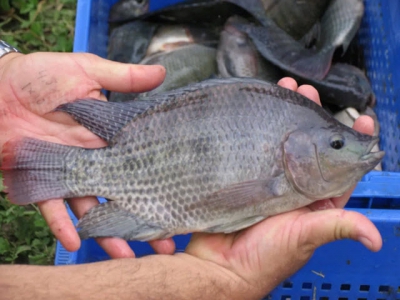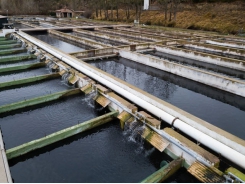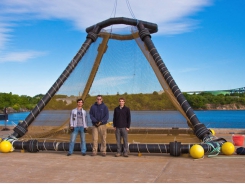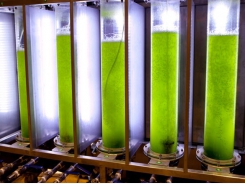10 paths to low productivity and profitability with tilapia in sub-Saharan Africa (Part 1)

Reverse the course: Separate symptoms from practices where better management can be applied
Because tilapia will only grow up to its genetic potential under the best of culture conditions, the only way to grow much bigger or faster growing tilapia is to begin with a stock of the best strain. Photo by Darryl Jory.
Small-scale semi-intensive pond farming of tilapia in sub-Saharan Africa (SSA) is beset with low annual productivity in the range of 1,000 (or less) to 3,000 kg/hectare, with the typical reports skewed toward the low end of this range.
Experimental studies routinely document that a lot more tilapia could be produced in these systems without aeration, just by adhering to better management practices. The low productivity, coupled with a high cost of labor and feed in most SSA countries, leads to low profitability, which is considered nearly synonymous with low productivity when discussed in the SSA context.
No one disputes the facts of low productivity and profitability of pond-based tilapia farming in the region, yet there is plenty of debate regarding the causes and how to overcome them. In this article, I argue that many of the reasons proffered by professionals for the low productivity are valid. There is no single explanation for the problem; consequently, only by comprehensively examining the causes and how they interact can we develop effective solutions.
Drawing on my experiences in several SSA countries, particularly Ghana, I have tried to simplify the issues in a single chart (Fig. 1), separating the practices or root causes for which interventions in the form of better management practices can be applied (numbered 1 to 10 in blue boxes) from the consequences or symptoms of the practices.
Symptoms cannot be changed directly. By following the paths to low productivity in the diagram, it becomes obvious that 1) we often wrongly focus our concerns on symptoms (e.g., slow growth or high mortality); and 2) although a marginal increase may result, dealing with one or a few of the root causes of low productivity does not guarantee that productivity and profitability will increase substantially.

Fig. 1: The interrelated paths to low productivity (and profitability) of tilapia ponds and farms in sub-Saharan Africa. Boxes represent conditions that can be influenced with appropriate interventions (i.e., root causes) to increase productivity and profitability. Continuing the status quo practices leads to the red font conditions (symptoms) which are only preventable indirectly through action on the root causes.
A brief discussion of each of the root causes of low productivity and profitability of pond-based tilapia farming in sub-Saharan Africa will form the basis of my prescription of how to reverse the course and lead to higher productivity and profitability.
1-2: Genetically inferior strains, poor broodstock management and inbreeding
The majority of tilapia farmers in SSA grow Nile tilapia (Oreochromis niloticus) for reasons that are technical, historical and part of the legacy of the policies of development partners that have operated in the region. The selection and breeding of tilapia strains for culture in SSA, however, has not followed a smooth or well documented process: There are currently as many policies and processes as there are countries.
But one common feature is the proliferation of wild, mixed, unknown and inferior strains of tilapia that grow slower and attain asymptotic size of 250 to 500 grams, only about one-third to one-half the size of the genetically improved farmed tilapia (GIFT) strains of O. niloticus grown in Asia, particularly in China. Fish will only grow up to their genetic potential under the best of culture conditions. Therefore, the only way to grow much bigger or faster growing tilapia as aspired to by many farmers is to begin with a stock of the best strain.
Closely associated with the problem of inferior strains is broodstock mismanagement. Many hatcheries and farms are managed by people with limited or no training in genetics or fish breeding. If at all attempted, selective breeding is done in a rudimentary fashion, by retaining the largest individuals of one generation and using them as breeders for the next, rapidly moving toward severe inbreeding of a stock that was probably a small number to begin with.
The result of inbreeding depression is slow growth. Even high performing strains can be rendered similarly ineffective by poor brood management and haphazard selective breeding. A better approach to ensure high-quality seed at the start of each production cycle is to leave selective breeding to the trained professionals and obtain fresh fingerlings or broodstock from certified hatcheries.
3-4: Ineffective sex-reversal and stocking fry or small fingerlings in grow-out ponds
Although technologies for all-male tilapia production, through hormonal sex-reversal or by other means, have been perfected for decades, there is little to no evidence that their use has permeated small-scale pond production systems in SSA. Where demand is high the situation is exacerbated by the pressure on outgrowers to procure fry (e.g., 1 to 2 grams) instead of larger fingerlings.

Fig. 2: Approximately 30-gram Nile tilapia male (left) and female (right) showing sexual differentiation in throat coloration and the genital papillae. Photo by Nathaniel G. Adjei.
Whenever I have observed purportedly all-male fry or small fingerlings in ponds in Ghana to sizes at which tilapia sexes are identifiable, 7 to 30 percent of fingerlings have been female! At failure rates approaching 1 in 10 fingerlings as female at best, production might as well be considered mixed sex. Uncontrollable in-pond breeding and mixed sizes result from such situations and further depress growth.
Ironically, slow growth motivates longer grow-out cycles for farmers who assume that fish will continue to grow if they are kept longer in the pond, which create opportunity for multiple generations of tilapia to exist in the same pond with inconsistent production outcomes. Fry and smaller fingerlings are supposed to be cheaper but cost is indirectly incurred in their higher natural and handling mortality, in addition to having to feed a more expensive starter feed and a higher chance of females that may be ultimately discarded.
A better management practice is to raise fry or fingerlings in hapas sited within the ponds to the size where the sexes can be identified but not large enough to reproduce, and then sort by size and sex for stocking. Under water conditions of 27 to 30 degrees-C, 2-gram fry of the Akosombo (Volta) strain of Nile tilapia, fed high-quality starter feed at 10 percent body weight in green water, will attain 30 grams in 6 to 8 weeks, at which time male and females can be identified.
It is a tedious process for large farms to sort tilapia sexes manually, but for the majority of pond farms that are only a fraction of a hectare, this step is feasible and cost-saving. The main experience needed is the ability to identify tilapia sexes, a skill for which farmers can be trained with a relatively high degree of success.
Có thể bạn quan tâm
Phần mềm

Phối trộn thức ăn chăn nuôi

Pha dung dịch thủy canh

Định mức cho tôm ăn

Phối trộn phân bón NPK

Xác định tỷ lệ tôm sống

Chuyển đổi đơn vị phân bón

Xác định công suất sục khí

Chuyển đổi đơn vị tôm

Tính diện tích nhà kính

Tính thể tích ao hồ




 10 paths to low productivity and profitability with…
10 paths to low productivity and profitability with…  US: microalgae co-product may have role in cutting…
US: microalgae co-product may have role in cutting…